It’s been a disappointing start to the season for Manchester United, but we’ve identified five angles that could give fans, and Erik ten Hag, hope.
When Rasmus Højlund raced through and neatly clipped a finish past Fernando Muslera to put Manchester United in front for a second time against Galatasaray in their UEFA Champions League group stage match on Tuesday, it felt like a potential turning point.
When Kerem Aktürkoğlu equalised moments later after some more astonishingly poor defending from the hosts at Old Trafford, it felt like a familiar turn back.
That gut punch was followed by a red card to Casemiro, a Mauro Icardi winner for the visitors and a sixth defeat for United in their last nine games in all competitions.
It wasn’t meant to be this way.
Fans of every club are allowed some pre-season optimism, but it has already gone from title talk to crisis concerns for Manchester United, and we’re only just into October. After a relatively positive first 12 months at United, Erik ten Hag is now facing questions about his ability to get the club back to where they feel they belong.
At the start of the season, the Opta supercomputer gave Man Utd a 63.2% chance of finishing in the top four. Now, after taking just nine points from their first seven Premier League games in 2023-24, United are given only a 4.0% probability of qualifying for the Champions League again. The supercomputer currently has their likeliest finish as ninth, which would have been unthinkable before a ball was kicked this season. They’re also considered likelier to get relegated (0.06% chance) than they are to win the title (0.01%).
The supercomputer has run simulations for the Champions League as well, with United now having just a 32.9% likelihood of progressing from Group A after opening with defeats to Bayern Munich and Galatasaray. Ten Hag’s men only won the competition 0.45% of the time in the 10,000 simulations the supercomputer processed.
If you’re a Manchester United fan reading this, you may be feeling pretty low, but as ever, we’re here to help. Here are five things the club can either do or point to as a reason for optimism as they look to get their season back on track.
- Getting Players Back from Injury
All teams get injuries. Or at least, that’s what you’ll be told if you ever suggest it as an excuse for poor form, and with some justification.
Getting injuries is one thing but getting them all in one area is another entirely. Just ask Liverpool fans. They may not have had a lot of them in the 2020-21 season, but they did lose all of their senior centre-backs at the same time for a significant chunk of the campaign, which ultimately derailed their title charge early on and ended with them almost missing out on the top four.
United’s problem at the moment is at left-back, as they don’t have any to call on. With Luke Shaw, Tyrell Malacia and loan signing Sergio Reguilón all sidelined, Sofyan Amrabat has had to fill in of late, the effects of which were seen on Tuesday as the Morocco international struggled in an unfamiliar role.
Across the defence there have been absences, with first-choice centre-back pairing Lisandro Martínez and Raphaël Varane playing just 197 minutes together, and Aaron Wan-Bissaka already nearly spending a month out. They’ve also had star signings Mason Mount and Højlund miss some of the early part of the campaign with knocks, while the respective Antony and Jadon Sancho situations certainly don’t help.
Few managers ever have a full squad available to them, but if Ten Hag can get back at least one proper option in each position, it would potentially allow the team to build up some consistency and confidence. Especially in defence, which could help with this next entry.
- Stop Relying on the Goalkeeper to Save the Day
United have lost six of their 10 matches in all competitions this season (W4). They have also conceded 18 goals in all competitions, their most at this stage of a season since 1966-67 (20). Those two facts don’t feel particularly separate.
But let’s not blame André Onana for all of that, even if some are suggesting it can’t be a coincidence that they’re shipping goals so soon after losing long-term shot-stopping extraordinaire David de Gea at the end of last season.
The Spaniard was synonymous with making save after save to keep United in games, arguably the best in the business at pulling off saves few others could in key moments, to the extent that the team had almost become overly reliant on his brilliance.
As we previously pointed out, though, while De Gea’s ability to make vital saves was seemingly second to none at his peak, that had reduced in recent seasons.
Onana has made some good saves this season, but he is also conceding plenty. The former Ajax and Inter man was signed because he is better than De Gea with his feet, but when the ball keeps ending up in your net, that feels like a bigger issue than being able to play out from the back.
Looking at the numbers, Onana has played in all 10 of United’s games so far this season and has faced 50 shots on target, conceding 17 goals (excluding own goals) from 15.8 expected goals on target (xGOT). That means he’s conceded around 1.2 goals more than a goalkeeper would usually be expected to.
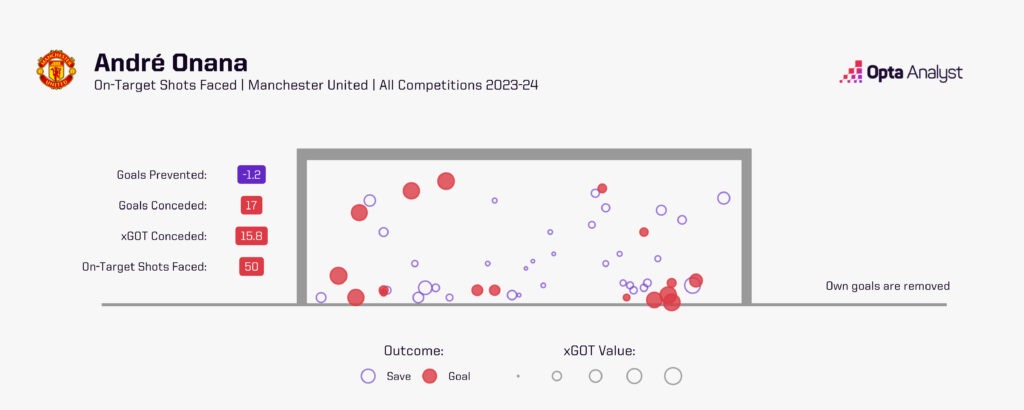
However, in De Gea’s first 10 games of last season, he conceded 17 goals from just 43 shots on target, with an xGOT of 14.3 (conceding 2.7 goals more than expected). When you consider the European games in that period were in the Europa League rather than the Champions League, Onana’s record doesn’t look too bad compared to his predecessor.
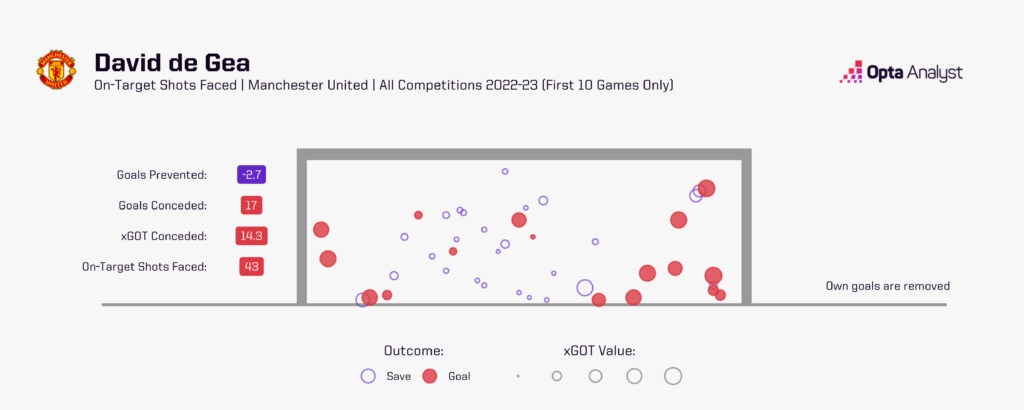
The Cameroon international has not entirely covered himself in glory yet, but it feels like the main issue has been a lack of protection. Which leads us to…
- Restore the Real Casemiro or Turn to Amrabat
Of all the things that helped turn around United’s fortunes last season, the signing of Casemiro felt like one of the biggest.
The former Real Madrid midfielder brought a win-at-all-costs attitude with him that had been a key missing ingredient at the club before then. Big tackles, big goals, and so often a big player when it mattered.
This season, though, it just doesn’t feel the same. Of United players to feature in at least half of their 10 games so far, only Wan-Bissaka (3.2) has averaged more tackles per 90 than Casemiro (2.9), though none of his teammates have been getting dribbled past by an opponent as often as his 2.4 times per 90. In the Premier League, only Liverpool’s Dominik Szoboszlai has been dribbled past by an opponent more often, but unlike Casemiro, the Hungarian isn’t a defensive midfielder and often the last line of protection in front of the defence.
He also isn’t looking after the ball particularly well. Fellow midfielders Bruno Fernandes (76%) and Christian Eriksen (82.9%) are hardly breaking passing accuracy records either, but given Casemiro (83.4%) is the deeper-lying midfielder, you would think he would be the one to control things while the others look for the high-risk, high-reward passes. His below pass map against Galatasaray shows how often he tried to force things, and how often it ended with the Turkish side getting the ball.
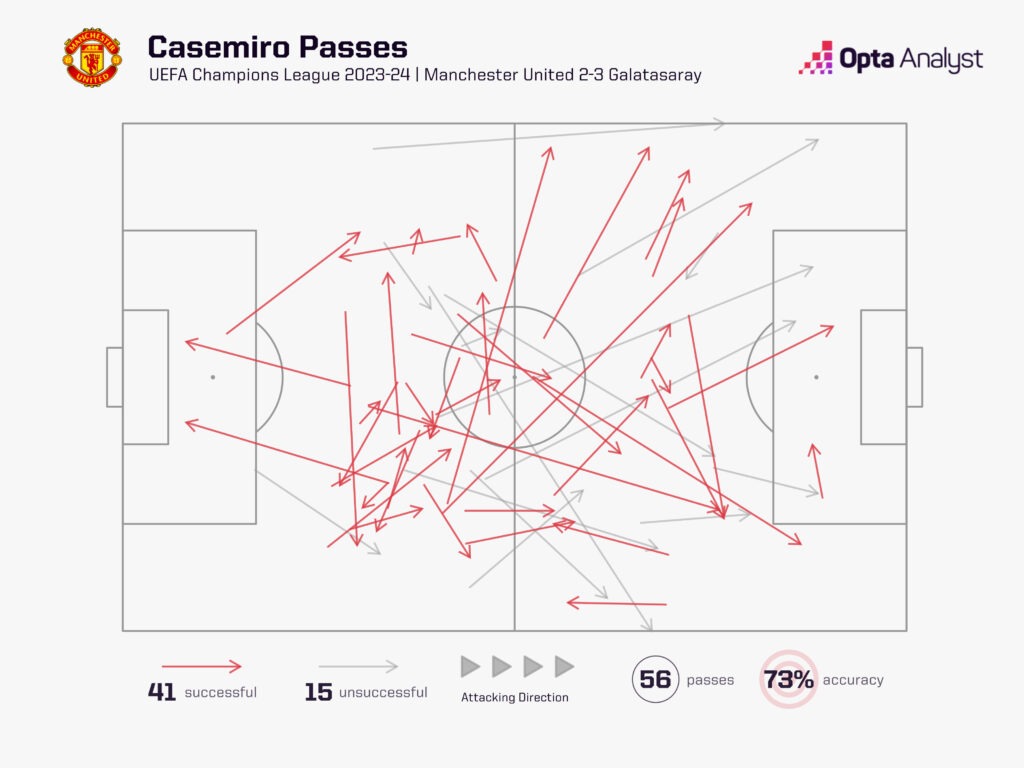
The main plus is he is still, inexplicably, one of United’s chief goal threats. He is their top scorer in all competitions this season with four goals, while only Fernandes and Marcus Rashford (both 28) have attempted more than his 20 total shots.
Casemiro’s second yellow card against Galatasaray for a wild challenge on Dries Mertens was a desperate attempt to prevent a goal after Onana’s hospital pass; some might say he didn’t have much of a choice, but it was undoubtedly rash and clumsy.
If United work out how to get the Brazil international anywhere near last season’s form, though, it would make a big difference. If not, maybe Ten Hag should consider putting the ever-energetic Sofyan Amrabat in his usual position?
The man on loan from Fiorentina ranked joint third among midfielders for tackles (16) at last year’s FIFA World Cup and led the way for possession regains (57). His 26 recoveries in the defensive third was also a high among the same group of players. In Serie A, his 89.3% passing accuracy in open play was only bettered by four midfielders (min. 1,000 minutes played) last season.
Alternatively, Amrabat could be deployed alongside Casemiro, providing greater protection to the back four and meaning there’s less reliance on the latter defensively.
- Get Marcus Rashford Back on Form
Speaking of players who need to rediscover their 2022-23 selves, Rashford has been a shadow of that leading figure so far.
He scored 30 goals in 56 games in all competitions last season from 167 total shots (including blocks) worth 24.3 expected goals (xG).
In 2023-24, Rashford has played nine times, scoring just once from 28 shots and 2.7 xG. His impressive shot conversion rate from last season has dipped alarmingly from 18% to just 3.6%, and as a result, a player who averaged a goal every 143 minutes in 2022-23 has only scored once in 768 minutes this term.
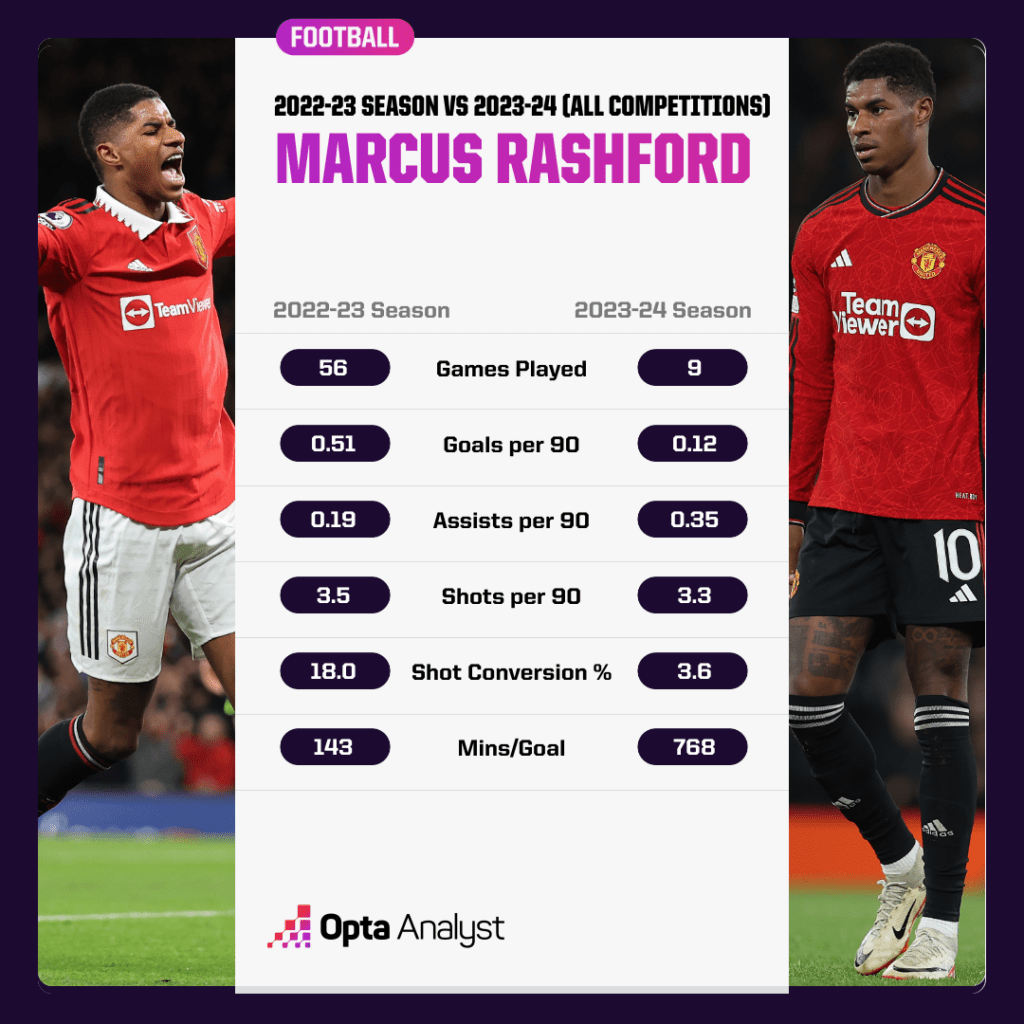
Until Tuesday, when his decision to try to square to Fernandes instead of shoot drew groans of astonishment from fans, there had been few signs of shyness; after all, only Erling Haaland (32) has attempted more than Rashford’s 28 shots in the Premier League. Crucially, though, he seems to be failing to work the space to shoot as often as he used to. Of Rashford’s 28 shot attempts, 17 have been blocked. That’s five more than anyone else in the league (Eberechi Eze – 12). Of his 108 shots in the Premier League last season, only 27 were blocked.
In the recent 3-1 home defeat to Brighton, he was involved in eight shot-ending passing sequences, but all of them were him taking the shot, and he didn’t score any of them. Then, against Galatasaray, he didn’t attempt a single shot in 68 minutes on the pitch; whether that was a concerted effort to calm it down a bit or his form eventually manifesting itself as a lack of confidence, who knows.
But like Casemiro, it’s hard to believe Rashford has become a significantly worse player almost overnight, so if Ten Hag can help him rediscover the confidence that was practically oozing out of him last season, there’s no reason to think he won’t be back to scoring big goals in big moments again. His assist on Tuesday was well executed for this next man.
- Build Around Rasmus Højlund
It might feel like this article has so far focused on negative aspects that fans will hope can improve. So, let’s finish with one of the few positives that already exists at Old Trafford.
To take us back to the start, Højlund’s goal to make it 2-1 against Galatasaray had a real aura to it. The game was in the balance before Davinson Sánchez slipped, Højlund collected the ball and started running. He kept running, maintained control of the ball in wet conditions and finished with aplomb (a word that only seems to exist to describe nice finishes). It didn’t do United much good in the end, but that’s hardly the big striker’s fault.
Højlund might not have arrived with many senior goals to his name despite his big fee in the summer, but you can already see what attracted United to him. His movement, touch, and confidence already seem to be of the required level.
The young Dane is yet to score his first Premier League goal, but if his teammates can create the chances (rather than relying on slipping defenders) then you’d already back Højlund to put them away. He tried to carry the team on his back on Tuesday but was ultimately let down at the other end.
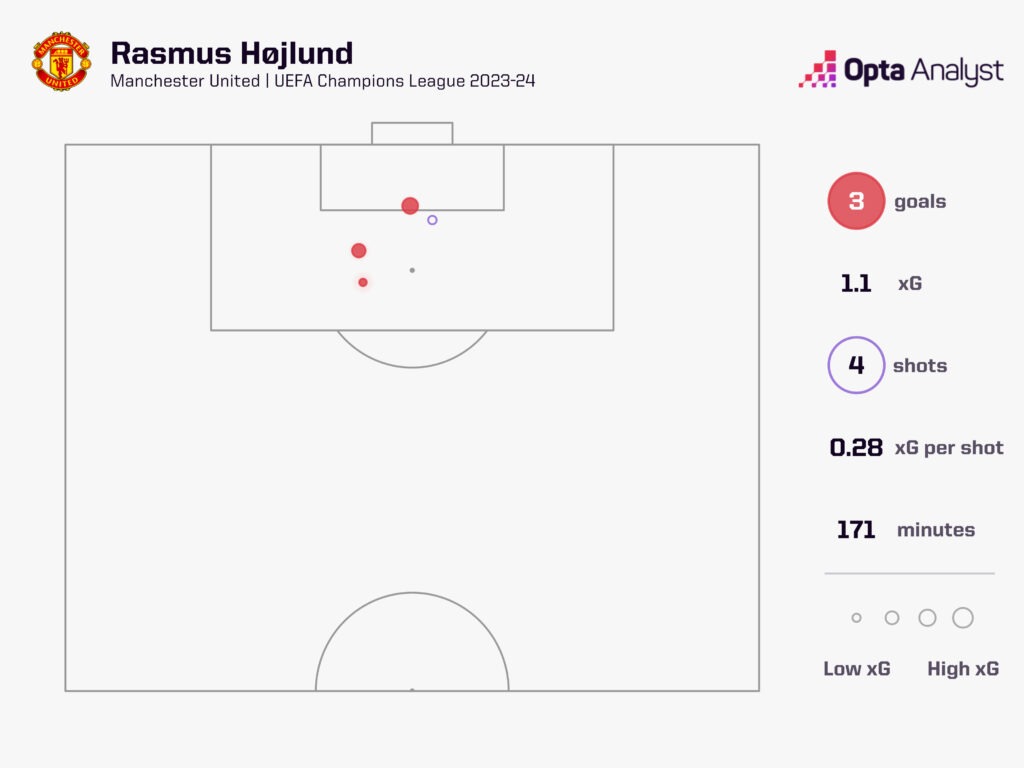
At 20 years and 241 days, Højlund became the youngest player to score in his first two Champions League appearances since Erling Haaland in 2019, while he is the fourth player to have scored as many as three goals in his first two Champions League appearances for Man Utd, after Dimitar Berbatov (4), Romelu Lukaku (3) and Wayne Rooney (3).
He may be trailing Casemiro as United’s overall top scorer, but scoring at 0.6 goals per 90, it shouldn’t be long before he’s leading the way.
Solve these issues, and who knows? There is still a lot of football to be played. Of course, for some it might’ve seemed like we could have just written something that rhymes with ‘Blazers Out’ and stopped there, but for now, Manchester United’s issues must be solved on the pitch.
